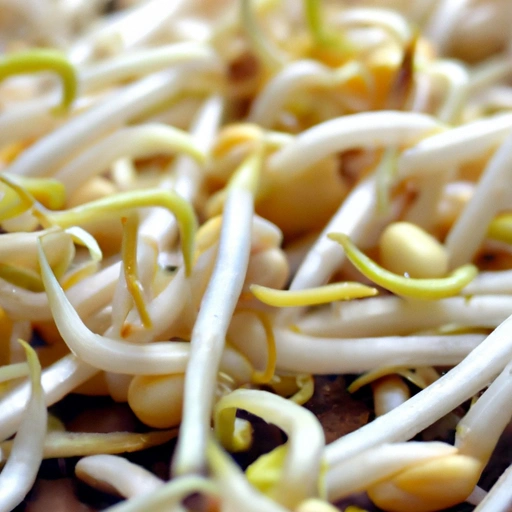Bean Sprout
Description

Bean sprouts are the tender, edible shoots of germinated beans, commonly derived from mung beans and soybeans. They are a popular ingredient in various cuisines around the world, appreciated for their crunchy texture and subtle, slightly nutty flavor. Bean sprouts can be eaten raw or cooked, and are a versatile component in salads, stir-fries, sandwiches, and more. They are often found in Asian dishes but have gained popularity globally as a healthful and nutritious addition to many meals.
Common uses
Bean sprouts are commonly used in fresh salads, sandwich fillings, spring rolls, soups, and stir-fries. They are also a frequent addition to noodle dishes and rice preparations. Due to their mild flavor, they can complement a variety of ingredients without overpowering the dish. Bean sprouts are often used as a garnish, offering a crunch and visual appeal to meals.
Nutritional value
Calories
A standard serving of bean sprouts (about 1 cup or approximately 104 grams/3.7 ounces) contains roughly 31 calories.
Protein
This same serving size offers about 3 grams (0.1 ounces) of protein, making bean sprouts a good plant-based protein source.
Fat
Bean sprouts are low in fat, with less than 0.5 grams (0.02 ounces) per serving.
Carbohydrates
They are also low in carbohydrates, with about 6 grams (0.2 ounces) per 1 cup serving.
Vitamins
Bean sprouts are a good source of Vitamin C and also provide small amounts of the B vitamins, particularly folate.
Minerals
They contain essential minerals such as iron, magnesium, phosphorus, and potassium.
Health benefits
Bean sprouts offer several health benefits. They are high in antioxidants and contain beneficial enzymes that can aid digestion. The presence of vitamins and minerals supports the immune system and contributes to bone health. Bean sprouts have a high water content, which can help with hydration and may contribute to weight management due to their low-calorie profile and fiber content.
Potential risks
Although bean sprouts are generally safe to eat, they have been associated with foodborne illnesses when consumed raw. This is due to the warm, moist conditions needed to grow sprouts, which are also ideal for the growth of bacteria like Salmonella and E. coli. To minimize the risk, it is recommended to cook sprouts thoroughly, purchase them from reputable sources, and keep them refrigerated. People with compromised immune systems should be particularly cautious and might opt to avoid raw sprouts altogether.
Common recipes
Bean sprouts are featured in a variety of recipes including the classic Vietnamese pho, Korean bibimbap, pad Thai, and various stir-fry dishes.
Cooking methods
They can be steamed, boiled, stir-fried, or blanched. When cooking, it is usually best to add bean sprouts towards the end of the cooking process to maintain their crisp texture.
Pairing with other ingredients
Bean sprouts pair well with ingredients like tofu, chicken, beef, shrimp, garlic, ginger, and a variety of vegetables like bell peppers, carrots, and mushrooms. They also work well with sauces such as soy sauce, sesame oil, and rice vinegar.
Summary
Bean sprouts are a nutritious and versatile food ingredient that can enhance a variety of dishes with their crunch and nutritional benefits. They are an integral part of many Asian cuisines but have been embraced by cultures around the world for their healthful properties. While there are some potential risks associated with consuming raw sprouts, these can be mitigated by proper handling and cooking, making bean sprouts a safe and healthy addition to your diet.